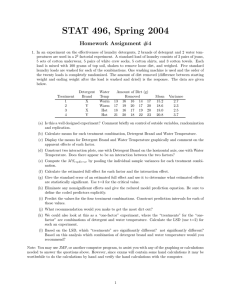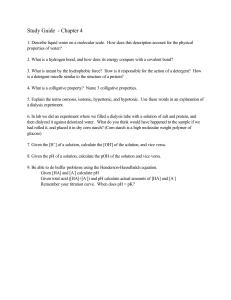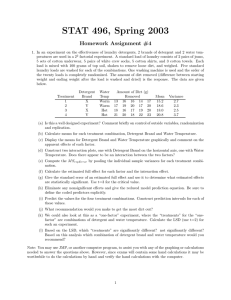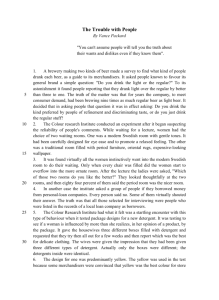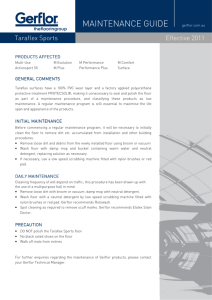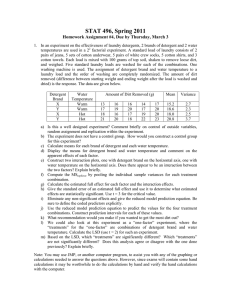Document 12073072
advertisement
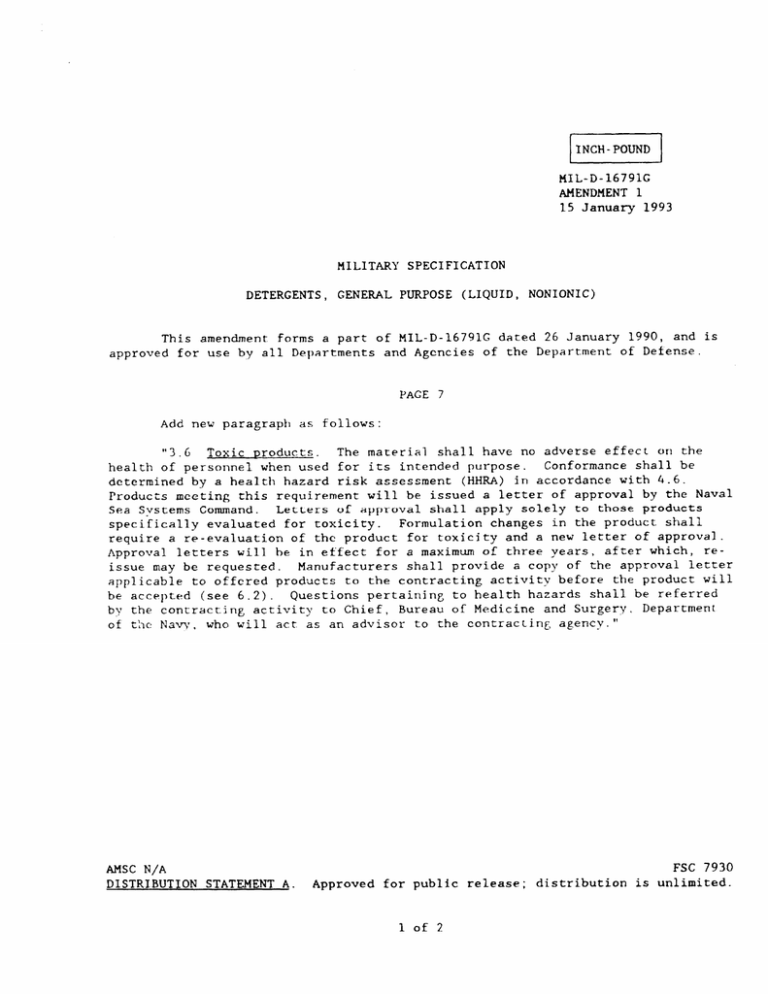
INCH-POUND MIL-D-16791G 26 January 1990 SUPERSEDING MIL-D-16791F 27 February 1985 MILITARY SPECIFICATION DETERGENTS, GENERAL PURPOSE (LIQUID, NONIONIC) This specification is approved for use by all Departments and Agencies of the Department of Defense. 1. SCOPE 1.1 Scope. This specification covers both water-soluble and oil-soluble nonionic detergents for use in preparing cleaning solutions which are effective in, and rinsable with, either fresh or sea water. 1.2 Classification. (see 6.2): Detergent (nonionic) shall be of the following types, as specified Type I - Water-soluble Type II - Oil-soluble. 2. APPLICABLE DOCUMENTS 2.1 Government documents. 2.1 Specification and standards. The following specifications and standards form a part of this document to the extent specified herein. Unless otherwise specified, the issues of these documents are those listed in the issue of the Department of Defense Index of Specifications and Standards (DODISS) and supplement thereto, cited in the solicitation(see 6.2). ÚÄÄÄÄÄÄÄÄÄÄÄÄÄÄÄÄÄÄÄÄÄÄÄÄÄÄÄÄÄÄÄÄÄÄÄÄÄÄÄÄÄÄÄÄÄÄÄÄÄÄÄÄÄÄÄÄÄÄÄÄÄÄÄÄÄÄÄÄÄÄÄÄÄÄÄÄÄÄÄÄÄÄÄÄÄ¿ ³ Beneficial comments (recommendations, additions, deletions) and any pertinent data ³ ³ which may be of use in improving this document should be addressed to: Commander, ³ ³ Naval Sea System Command, SEA 55Z3, Department of the Navy, Washington, DC ³ ³ 20362-5101 by using the self-addressed Standardization Document improvement ³ ³ Proposal (DD Form 1426) appearing at the end of this document or by letter. ³ ÀÄÄÄÄÄÄÄÄÄÄÄÄÄÄÄÄÄÄÄÄÄÄÄÄÄÄÄÄÄÄÄÄÄÄÄÄÄÄÄÄÄÄÄÄÄÄÄÄÄÄÄÄÄÄÄÄÄÄÄÄÄÄÄÄÄÄÄÄÄÄÄÄÄÄÄÄÄÄÄÄÄÄÄÄÄÙ DISTRIBUTION STATEMENT A. Approved for public release; distribution is unlimited. SPECIFICATIONS FEDERAL PPP-B-640 Boxes, Fiberboard, Corrugated, Triple-Wall PPP-C-96 Cans, Metal, 28 Gage and Lighter PPP-D-729 Drums, Shipping and Storage, Steel, 55-Gallon (208 Liters) PPP-P-704 Pails, Metal, (Shipping, Steel, 1 through 12 Gallons) VV-F-800 Fuel Oil, Diesel STANDARDS FEDERAL FED-STD-313 Material Safety Data, Transportation Data and Disposal Data for Hazardous Materials furnished to Government Activities MILITARY MIL-STD-105 Sampling Procedures and Tables for Inspection by Attributes MIL-STD-129 Marking for Shipment and Storage MIL-STD-147 Palletized Unit Loads (Unless otherwise indicated, copies of federal and military specifications and standards are available from the Naval Publications and Forms Center, (ATT: NPODS), 5801 Tabor Avenue, Philadelphia, PA 19120-5099.) 2.2 Non-Government publications. The following documents form a part of this document to the extent specified herein. Unless otherwise specified, the issues of the documents which are DODD adopted are those listed in the issue of the DODISS cited in the solicitation. Unless otherwise specified, the issues of documents not listed in the DODISS are the issues of the documents cited in the solicitation (see 6.2). AMERICAN SOCIETY FOR TESTING AND MATERIALS (ASTM) D 93 Standard Test Methods for Flash Point by Pensky-Martens Closed Tester (DOD adopted) D 95 Standard Test Methods for Water in Petroleum Products and Bituminous Materials By Distillation (DOD adopted) D 3699 Standard Specification for Kerosine (DOD adopted) E 326 Standard Test Method for Hydroxyl Groups By Phthalic Anhydride Esterification (Application for copies should be addressed to the American SOciety for Testing and Materials, 1916 Race Street, Philadelphia, PA 19103.) (Non-Government standards and other publications are normally available from the organizations that prepare or distribute the documents. These documents also may be available in or through libraries or other information services.) 2.3 Order of precedence. In the event of a conflict between the test oft this document and the references cited herein, the text of this document takes precedence. Nothing in this document, however, supersedes applicable laws and regulations unless a specific exemption has been obtained. 3. REQUIREMENTS 3.1 Material. The detergent shall be a liquid, nonionic surface active agent containing a minimum of 99 percent active ingredient for type I and type II. It shall be the alkyl aryl polyether alcohol (alkyl phenol either of polyethylene glycol) type where the alkyl group is iso-octyl or isononyl, or the linear alkyl polyether alcohol (alkyl ether of polyethylene glycol) type where the alkyl group is linear primary or secondary alkyl. 3.1.1 Appearance. Detergent shall be a liquid at 77 degrees Fahrenheit (def. F) 25 degrees Celsius (deg. C)). A slight haze is permissible. 3.1.2 Water content. 3.1.3 Ash content. Water content shall not exceed 0.5 percent (see 4.4.1). Ash content shall not exceed 0.25 percent (see 4.4.2). 3.1.4 Nitrogen, sulfur and phosphorous content. Detergent shall give no indication for these elements (see 4.4.3). Detergents giving a positive qualitative result for these elements shall be further subjected to an acceptable standard quantitative test. When tested quantitatively, the limits on sulfur, nitrogen and phosphorus shall be 0.2 percent, 0.1. percent, and 0.1 percent by weight respectively. 3.1.5 Emulsifying ability. The specific type detergent shall produce an emulsion which on standing has shown no more phase separation than specified in table I (see 4.4.4). TABLE I. Phase separation. ÚÄÄÄÄÄÄÄÄÄÄÄÂÄÄÄÄÄÄÄÄÄÄÄÄÄÄÄÄÄÄÄÄÄÄÄÄÄÄÄÄÄÂÄÄÄÄÄÄÄÄÄÄÄÄÄÄÂÄÄÄÄÄÄÄÄÄÄÄÄÄÄÄÄÄÄÄÄÄÄÄ¿ ³ ³ ³ ³ ³ ³ ³ Number of milliliters ³ Time ³ Aqueous phase ³ ³ Type ³ of separation ³ (min) ³ ³ ÃÄÄÄÄÄÄÄÄÄÄÄÅÄÄÄÄÄÄÄÄÄÄÄÄÄÄÄÄÄÄÄÄÄÄÄÄÄÄÄÄÄÅÄÄÄÄÄÄÄÄÄÄÄÄÄÄÅÄÄÄÄÄÄÄÄÄÄÄÄÄÄÄÄÄÄÄÄÄÄÄ´ ³ ³ ³ ³ ³ ³ I ³ 1.5 ³ 60 ³ Distilled water ³ ³ ³ ³ ³ ³ ³ I ³ 3.5 ³ 5 ³ Synthetic sea water ³ ³ ³ ³ ³ ³ ³ II ³ 3.0 ³ 60 ³ Distilled water ³ ³ ³ ³ ³ ³ ³ II ³ 3.0 ³ 5 ³ Synthetic sea water ³ ÀÄÄÄÄÄÄÄÄÄÄÄÁÄÄÄÄÄÄÄÄÄÄÄÄÄÄÄÄÄÄÄÄÄÄÄÄÄÄÄÄÄÁÄÄÄÄÄÄÄÄÄÄÄÄÄÄÁÄÄÄÄÄÄÄÄÄÄÄÄÄÄÄÄÄÄÄÄÄÄÄÙ 3.1.6 Flash point. The flash point of the detergent shall be not less than 340 deg. F (171 deg. C) (see 4.4.10). 3.1.7 Recovered materials. Unless otherwise specified herein, all material incorporated in the products covered by the specification shall be new and may be fabricated using materials produced from recovered materials to the minimum extent practicable without jeopardizing the intended use. The term "recovered materials" means materials which have been collected or recovered from solid waste and reprocessed to become a source of raw materials, as opposed to virgin raw materials. None of the above shall be interpreted to mean that the use of used products is allowed under this specification unless otherwise specifically specified. 3.2 Type I, water-soluble. 3.2.1 Cloud point. The cloud point of the detergent shall be not less than 120 deg. F (49 deg. C) and not more than 160 deg. F (71 deg. C) (see 4.4.5). 3.2.2 Compatibility. No cloudiness, precipitation or sediment shall be formed when the detergent is mixed with anionic and cationic wetting agents (see 4.4.6). 3.2.3 Chemical stability. (see 4.4.7). Detergent shall be chemically stable to acid and oxidation 3.2.4 pH value. The pH of a 1 percent solution of the detergent in distilled water at 77 deg. F (25 deg. C) shall fall within the range of 6.0 to 8.0 (see 4.4.9). 3.2.5 Hydroxyl number. The detergent shall have a maximum hydroxyl number of 139 milligrams (mg) of potassium hydroxide per gram of sample (see 4.4.11). 3.2.6 Labeling. Unless otherwise specified (see 6.2), each container of type I detergent shall be durably and legibly labeled as follows: "DETERGENT (Water-soluble, nonionic) This product when dissolved in either fresh water or sea water will efficiently remove grease, oil and dirt from a wide variety of surfaces. WARNING Do not take internally. Keep out of eyes. Use chemical worker's goggles to prevent material from being splashed into eyes when being mixed and/or applied. In addition to goggles, a plastic face shield may be used to protest the face. NOTE: The face shield is not to be used in lieu of chemical worker's goggles; it is an extension to the basic eye protection. If swallowed, induce vomitting and call a physician. For eyes, flush with plenty of water and get medical attention. May be irritating to the skin. Use of chemical gloves is recommended. For most cleaning operations, 1/4 to 1/2 ounce of detergent in a gallon of fresh water or sea water,preferable hot, is sufficient. Very heavy soils may require as much as 1 ounce of product. DO NOT EXCEED RECOMMENDED MIX QUANTITY. IF CLEANING BY HAND - CHEMICAL PROTECTIVE GLOVES SHALL BE USED. SKIN IRRITATION OR OTHER ALLERGIC REACTION MAY OCCUR IF THESE INSTRUCTIONS ARE DISREGARDED. For some appli- cations, the additions of 1 to 2 ounces of an alkali, such as sodium metasilicate or machine dishwashing compound, will improve performance. If alkalies are used, the solution shall be prepared with fresh water. Scrub, mop or wipe with the solution into the oily soil and then rinse away the loosened soil with either fresh water or sea water. Cold water rinsing is satisfactory but hot water may be used when it is desired to have steel surfaces dry quickly. Small accessible areas may also be wiped dry if rinsing cannot be done easily. Closed systems such as compressed air lines, heat exchangers and similar items may be cleaned by recirculating a hot solution of the detergent for 1 to 3 hours followed by rinsing." 3.3 Type II, oil-soluble. 3.3.1 Solubility in kerosene. shall remain clear (see 4.4.8). Detergent shall form a clear solution in kerosene and 3.3.2 Hydroxyl number. The detergent shall have a maximum hydroxyl number of 150 mg of potassium hydroxide per gram of sample (see 4.4.11). 3.3.3 Labeling. Unless otherwise specified (see 6.2), each container of type II detergent shall be durably and legibly labeled in accordance with MIL-STD-129 as follows: "DETERGENT (Oil-soluble, nonionic) WARNING Do not take internally. Keep out of eyes. Use chemical worker's goggles to prevent material from being splashed into eyes when being mixed and/or applied. In addition to goggles, a plastic face shield may be used to protect the face. NOTE: The face shield is not to be used in lieu of chemical worker's goggles; it is an extension to the basic eye protection. If swallowed, induce vomiting and call a physician. For eyes, flush with plenty of water and get medical attention. May be irritating to the skin. Use of chemical gloves is recommended. This product, when dissolved in the proportion of 5 fluid ounces per gallon of kerosene, diesel fuel oil, high flash coal tar naphtha and similar hydrocarbon solvents will remove heavy deposits of grease, oil, sludge, some types of rustpreventive compounds and other similar soils. Kerosene and diesel fuel oil solutions are useful on petroleum oils and greases. Rust-preventive compounds, oxidized sludges, asphaltic and bituminous contamination are best removed with solutions of detergent in aromatic solvents such as the coal tar and petroleum aromatic naphthas. The solution of detergent in solvent is brushed, sprayed (nonatomizing spray) or flowed onto the soil, allowed to soak for 5 to 30 minutes and then rinsed with hot or cold fresh water or sea water. Scrubbing the solvent into the soil will improve results. IF CLEANING BY HAND - CHEMICAL PROTECTIVE GLOVES SHALL BE USED. SKIN IRRITATION OR OTHER ALLERGIC REACTION MAY OCCUR IF THESE INSTRUCTIONS ARE DISREGARDED. A hot water rinse will promote rapid drying. If many small objects to cleaned, a tank of solvent solution will be convenient for dipping the pieces which then can be rinsed in a tank of water or under pressure spray. WARNING Solvent solutions of detergent (oil-soluble), in the amount recommended, will not have flash points significantly different from that of the straight solvent. Therefore, the same precautions against fire hazard shall be observed as required for the particular solvent used." 3.4 Workmanship. The detergent shall be a clear homogeneous liquid free of dirt or foreign matter. The quality of the cleaning compound shall conform to the levels established here. 3.5 Material safety data sheet (MSDS). The contracting activity shall be provided a material safety data sheet at the time of contract award. The MSDS shall be provided in accordance with the requirements of FED-STD-313. The MSDS shall be included with each shipment of the material covered by this specification (see 6.5). 4. QUALITY ASSURANCE PROVISIONS 4.1 Responsibility for inspection. Unless otherwise specified in the contract or purchase order (see 6.2), the contractor is responsible for the performance of all inspection requirements (examinations and tests) as specified herein. Except as otherwise specified in the contract or purchase order, the contractor may use his own or any other facilities suitable for the performance of the inspection requirements specified herein, unless disapproved by the Government. The Government reserves the right to perform any of the inspections set forth in the specification where such inspections are deemed necessary to ensure supplies and services conform to prescribed requirements. 4.1.1 Responsibility for compliance. All items shall meet all requirements of sections 3 and 5. The inspection set forth in this specification shall become a part of the contractor's overall inspection system or quality program. The absence of any inspection requirements in the specification shall not relieve the contractor of the responsibility of ensuring that all products or supplies submitted to the Government for acceptance comply with all requirements of the contract. Sampling inspection, as part of the manufacturing operations, is an acceptable practice to ascertain conformance to requirements, however, this does not authorize submission of known defective material, either indicated or actual, nor does it commit the Government to accept defective material. 4.2 Sampling for quality conformance inspection. Sampling and inspection shall be performed as specified in 4.3.1 and 4.4, except where otherwise indicated. For purposes of sampling, an inspection lot for quality conformance inspection shall consist of all material of the same type offered for delivery at one time. 4.3 Examination of detergent. The material shall meet the requirements and be of the specified composition (see 3.1 an 6.3). 4.3.1 Examination of the detergent. The detergent shall be examined in accordance with the classification of defects specified in 4.3.1.1 through 4.3.1.2. The lot size, for purpose of determining the sample size, shall be expressed in units of filled containers of detergent of the same type for examination in 4.3.1.1 and 4.3.1.2. 4.3.1.1 Examination of the detergent container for defect in closure, appearance, markings, construction and workmanship. The sample unit for this examination shall be one filled container. Sampling shall be in accordance with table II. TABLE II. Inspection levels for examination. [1], [2], [3] ÚÄÄÄÄÄÄÄÄÄÄÄÄÄÄÄÄÄÄÄÄÂÄÄÄÄÄÄÄÄÄÄÄÄÄÄÄÄÄÄÄÂÄÄÄÄÄÄÄÄÄÄÄÄÄÄÄÄÂÄÄÄÄÄÄÄÄÄÄÄÄÄÄÄÄÄ¿ ³ Lot size ³ Sample Size ³ Accept ³ Reject ³ ÃÄÄÄÄÄÄÄÄÄÄÄÄÄÄÄÄÄÄÄÄÅÄÄÄÄÄÄÄÄÄÄÄÄÄÄÄÄÄÄÄÅÄÄÄÄÄÄÄÄÄÄÄÄÄÄÄÄÅÄÄÄÄÄÄÄÄÄÄÄÄÄÄÄÄÄ´ ³ ³ ³ ³ ³ ³ 0 -15 ³ 2 ³ 0 ³ 1 ³ ³ 16 - 50 ³ 3 ³ 0 ³ 1 ³ ³ 51 - 150 ³ 5 ³ 0 ³ 1 ³ ³ 151 - 500 ³ 8 ³ 0 ³ 1 ³ ³ 501 - 3,200 ³ 13 ³ 0 ³ 1 ³ ³ 3,201 - 35,000 ³ 20 ³ 0 ³ 1 ³ ³ 35,001 - over ³ 32 ³ 0 ³ 1 ³ ÀÄÄÄÄÄÄÄÄÄÄÄÄÄÄÄÄÄÄÄÄÁÄÄÄÄÄÄÄÄÄÄÄÄÄÄÄÄÄÄÄÁÄÄÄÄÄÄÄÄÄÄÄÄÄÄÄÄÁÄÄÄÄÄÄÄÄÄÄÄÄÄÄÄÄÄÙ [1] All defective items shall be replaced with acceptable items prior to lot acceptance. [2] Inspect sample size until reject criteria is reached. If reject criteria is reached, reject the lot or inspect the entire lot. [3] If entire sample is inspected and reject criteria is not reached, accept the lot. Examine Defect Container Not specified type, size or style container Any evidence of leakage from any part of the container, including cap closure, any unsound seam Any break, dent or other defect in body of container which may affect serviceability Closures not as specified; not equipped with screw cap and inner seal (as applicable) Exterior coating not as required Labeling Label, lithographing, printing or stenciling pertaining to the applicable information, and instructions for detergent use of the specified type material omitted, illegible, incorrect, incomplete or smeared Appearance of detergent Presence of dirt or foreign matter Not clear liquid (see 3.1.1) Not homogeneous 4.3.1.2 Examination of the detergent for defects in net contents. The sample unit for this examination shall be one filled container. Sample size shall be in accordance with table III. The average net contents shall be not less than the specified or indicted quantity. TABLE III. Sampling requirements. [1], [2], [3] ÚÄÄÄÄÄÄÄÄÄÄÄÄÄÄÄÄÄÄÄÄÂÄÄÄÄÄÄÄÄÄÄÄÄÄÄÄÄÄÄÄÂÄÄÄÄÄÄÄÄÄÄÄÄÄÄÄÄÂÄÄÄÄÄÄÄÄÄÄÄÄÄÄÄÄÄ¿ ³ Lot size ³ Sample Size ³ Accept ³ Reject ³ ÃÄÄÄÄÄÄÄÄÄÄÄÄÄÄÄÄÄÄÄÄÅÄÄÄÄÄÄÄÄÄÄÄÄÄÄÄÄÄÄÄÅÄÄÄÄÄÄÄÄÄÄÄÄÄÄÄÄÅÄÄÄÄÄÄÄÄÄÄÄÄÄÄÄÄÄ´ ³ ³ ³ ³ ³ ³ 0 -25 ³ 2 ³ 0 ³ 1 ³ ³ 26 - 150 ³ 3 ³ 0 ³ 1 ³ ³ 151 - 1,200 ³ 5 ³ 0 ³ 1 ³ ³ 1,201 - 35,000 ³ 8 ³ 0 ³ 1 ³ ³ 35,001 - Over ³ 13 ³ 0 ³ 1 ³ ÀÄÄÄÄÄÄÄÄÄÄÄÄÄÄÄÄÄÄÄÄÁÄÄÄÄÄÄÄÄÄÄÄÄÄÄÄÄÄÄÄÁÄÄÄÄÄÄÄÄÄÄÄÄÄÄÄÄÁÄÄÄÄÄÄÄÄÄÄÄÄÄÄÄÄÄÙ [1] [2] [3] All defective items lot acceptance. Inspect sample size is reached, reject If entire sample is the lot. shall be replaced with acceptable items prior to until reject criteria is reached. If reject criteria the lot or inspect the entire lot. inspected and reject criteria is not reached, accept 4.4 Testing of the detergent. The detergent shall be tested for the characteristics in table IV (see 6.3). One quart of material shall be drawn from each of five shipping containers and composited. The test sample shall consist of a 2-quart composite. Duplicate determinations shall be made on the composite. The average of the two determinations shall comply with the requirements when numerical results are specified. Both determinations shall pass when pass or fail requirements are applicable. Tests shall be conducted as specified in 4.4.1 through 4.4.11. TABLE IV. Testing procedures. ÄÄÄÄÄÄÄÄÄÄÄÄÄÄÄÄÄÄÄÂÄÄÄÄÄÄÄÄÄÄÄÄÄÄÄÄÄÄÄÄÄÂÄÄÄÄÄÄÄÄÄÄÄÄÄÄÄÄÄÄÄÄÄÄÂÄÄÄÄÄÄÄÄÄÄÄÄÄÄÄÄÄÄÄÄÄÄÄÄÄÄ ³ Specification ³ ³ Results reported as ³ reference ³ ³ Characteristics ³ ³ Number ÃÄÄÄÄÄÄÄÄÄÄÄÄÄÄÄÄÄÄÄÄÄÄÄÄÄÄ ³ ³ determinations per ³ ³ RequireTest ³ composite unit [1] ³ Pass or Numerically ³ ment method ³ ³ fail [1] to nearest ÄÄÄÄÄÄÄÄÄÄÄÄÄÄÄÄÄÄÄÅÄÄÄÄÄÄÄÄÄÄÄÄÄÄÄÄÄÄÄÄÄÅÄÄÄÄÄÄÄÄÄÄÄÄÄÄÄÄÄÄÄÄÄÄÅÄÄÄÄÄÄÄÄÄÄÄÄÄÄÄÄÄÄÄÄÄÄÄÄÄÄ Water content: ³ ³ ³ ³ ³ ³ Type I ³ 3.1.2 4.4.1 ³ Average of 2 ³ 0.01 percent Type II ³ 3.1.2 4.4.1 ³ Average of 2 ³ 0.01 percent ³ ³ ³ Type I and ³ ³ ³ type II: ³ ³ ³ ³ ³ ³ Ash content ³ 3.1.3 4.4.2 ³ Average of 2 ³ 0.01 percent ³ ³ ³ ÄÄÄÄÄÄÄÄÄÄÄÄÄÄÄÄÄÄÄÅÄÄÄÄÄÄÄÄÄÄÄÄÄÄÄÄÄÄÄÄÄÅÄÄÄÄÄÄÄÄÄÄÄÄÄÄÄÄÄÄÄÄÄÄÅÄÄÄÄÄÄÄÄÄÄÄÄÄÄÄÄÄÄÄÄÄÄÄÄÄÄ Nitrogen ³ 3.1.4 4.4.3 ³ Average of 2 ³ 0.01 percent ³ ³ ³ Sulfur ³ 3.1.4 4.4.3 ³ Average of 2 ³ 0.01 percent ³ ³ ³ Phosphorous ³ 3.1.4 4.4.3 ³ Average of 2 ³ 0.01 percent ³ ³ ³ Emulsifying ³ ³ ³ ability: ³ ³ ³ ³ ³ ³ Type I ³ ³ ³ ³ ³ ³ Distilled ³ ³ ³ water ³ 3.1.5 4.4.4 ³ Average of 2 ³ 0.2 mL ³ ³ ³ Sea water ³ 3.1.5 4.4.4 ³ Average of 2 ³ 0.2 mL TABLE IV. Testing procedures. (cont'd) ÄÄÄÄÄÄÄÄÄÄÄÄÄÄÄÄÄÄÄÂÄÄÄÄÄÄÄÄÄÄÄÄÄÄÄÄÄÄÄÄÄÂÄÄÄÄÄÄÄÄÄÄÄÄÄÄÄÄÄÄÄÄÄÄÂÄÄÄÄÄÄÄÄÄÄÄÄÄÄÄÄÄÄÄÄÄÄÄÄÄÄ ³ Specification ³ ³ Results reported as ³ reference ³ ³ Characteristics ³ ³ Number ÃÄÄÄÄÄÄÄÄÄÄÄÄÄÄÄÄÄÄÄÄÄÄÄÄÄÄ ³ ³ determinations per ³ ³ RequireTest ³ composite unit [1] ³ Pass or Numerically ³ ment method ³ ³ fail [1] to nearest ÄÄÄÄÄÄÄÄÄÄÄÄÄÄÄÄÄÄÄÅÄÄÄÄÄÄÄÄÄÄÄÄÄÄÄÄÄÄÄÄÄÅÄÄÄÄÄÄÄÄÄÄÄÄÄÄÄÄÄÄÄÄÄÄÅÄÄÄÄÄÄÄÄÄÄÄÄÄÄÄÄÄÄÄÄÄÄÄÄÄÄ ³ ³ ³ ³ ³ ³ Type II ³ ³ ³ ³ ³ ³ Distilled ³ ³ ³ water ³ 3.1.5 4.4.4 ³ Average of 2 ³ 0.2 mL ³ ³ ³ Type II ³ ³ ³ ³ ³ ³ Sea water ³ 3.1.5 4.4.4 ³ Average of 2 ³ 0.2 mL ³ ³ ³ Water Soluble, ³ ³ ³ type I: ³ ³ ³ ³ ³ ³ Cloud point ³ 3.2.1 4.4.5 ³ Average of 2 ³ 1.0 deg. F ³ ³ ³ Compatibility ³ 3.2.2 4.4.6 ³ 2 ³ X ³ ³ ³ Chemical ³ ³ ³ stability: ³ ³ ³ ³ ³ ³ Acid ³ 3.2.3 4.4.7.1 ³ 2 ³ X ³ ³ ³ Oxidation ³ 3.2.3 4.4.7.2 ³ 2 ³ X ³ ³ ³ pH value ³ 3.2.4 4.4.9 ³ Average of 2 ³ 0.1 pH ÄÄÄÄÄÄÄÄÄÄÄÄÄÄÄÄÄÄÄÁÄÄÄÄÄÄÄÄÄÄÄÄÄÄÄÄÄÄÄÄÄÁÄÄÄÄÄÄÄÄÄÄÄÄÄÄÄÄÄÄÄÄÄÄÁÄÄÄÄÄÄÄÄÄÄÄÄÄÄÄÄÄÄÄÄÄÄÄÄÄÄ TABLE IV. Testing procedures ÄÄÄÄÄÄÄÄÄÄÄÄÄÄÄÄÄÄÄÂÄÄÄÄÄÄÄÄÄÄÄÄÄÄÄÄÄÄÄÄÄÂÄÄÄÄÄÄÄÄÄÄÄÄÄÄÄÄÄÄÄÄÄÄÂÄÄÄÄÄÄÄÄÄÄÄÄÄÄÄÄÄÄÄÄÄÄÄÄÄÄ ³ Specification ³ ³ Results reported as ³ reference ³ ³ Characteristics ³ ³ Number ÃÄÄÄÄÄÄÄÄÄÄÄÄÄÄÄÄÄÄÄÄÄÄÄÄÄÄ ³ ³ determinations per ³ ³ RequireTest ³ composite unit [1] ³ Pass or Numerically ³ ment method ³ ³ fail [1] to nearest ÄÄÄÄÄÄÄÄÄÄÄÄÄÄÄÄÄÄÄÅÄÄÄÄÄÄÄÄÄÄÄÄÄÄÄÄÄÄÄÄÄÅÄÄÄÄÄÄÄÄÄÄÄÄÄÄÄÄÄÄÄÄÄÄÅÄÄÄÄÄÄÄÄÄÄÄÄÄÄÄÄÄÄÄÄÄÄÄÄÄÄ Oil soluble, ³ ³ ³ type II: ³ ³ ³ ³ ³ ³ Solubility ³ ³ ³ kerosene ³ 3.3.1 4.4.8 ³ 2 ³ X ³ ³ ³ Hydroxyl number ³ ³ ³ ³ ³ ³ Type I ³ 3.2.5 4.4.11 ³ Average of 2 ³ Number ³ ³ ³ Type II ³ 3.3.2 4.4.11 ³ Average of 2 ³ Number ³ ³ ³ Flash point ³ ³ ³ ³ ³ ³ Types I and ³ ³ ³ II ³ 3.1.6 4.4.10 ³ Average of 2 ³ Degree ÄÄÄÄÄÄÄÄÄÄÄÄÄÄÄÄÄÄÄÁÄÄÄÄÄÄÄÄÄÄÄÄÄÄÄÄÄÄÄÄÄÁÄÄÄÄÄÄÄÄÄÄÄÄÄÄÄÄÄÄÄÄÄÄÁÄÄÄÄÄÄÄÄÄÄÄÄÄÄÄÄÄÄÄÄÄÄÄÄÄÄ [1] If failure as indicated, report either description of failure or numerical point of failure, as applicable. 95. 4.4.1 Water content. The water content shall be determined in accordance with ASTM D 4.4.2 Ash content. One gram of sample shall be weighed and placed into a weighed 340 milliliter (mL) porcelain crucible. Heat gently to volatilize any water. Gradually increase the temperature, being careful to avoid boiling over and spattering. Finally, ignite to constant weight at 600 deg. C. Cool in a desiccator and weigh. The ash content shall be determined by the following calculation: Percent ash = 100A ÄÄÄÄ W Where: A = grams of residue W = grams of sample 4.4.3 Qualitative test for nitrogen, sulfur and phosphorus. 4.4.3.1 Reagents. 4.4.3.1.1 Ammonium molybdate solution. Ten grams of pure molybdic anhydride or 11.8 grams of molybdic acid (85 percent) shall be mixed with 40 mL of distilled water, then add 8 mL of ammonium hydroxide (specific gravity 0.90). When solution is complete, filter and pour the solution slowly, with constant stirring, into a mixture of 40 mL concentrated nitric acid (specific gravity 1.42) and 60 mL of distilled water. Allow the solution to settle for 24 hours, and use the clear supernatant liquid. 4.4.3.1.2 Barium chloride solution (approximately 10 percent). chloride shall be dissolved in 100 mL of distilled water. 4.4.3.1.3 Acetic acid solution, dilute (1 to 1). shall be mixed with distilled water. Ten grams of barium Equal volumes of glacial acetic acid 4.4.3.1.4 Nitric acid solution, dilute (1 to 2). One volume of concentrated nitric acid shall be mixed with 2 volumes of distilled water. 4.4.3.1.5 Phenolphthalein indicator. in 100 mL of 95 percent ethyl alcohol. 4.4.3.1.6 Red litmus test paper. supply companies. 4.4.3.2 One gram of phenolphthalein shall be dissolved Red litmus test paper is obtainable from laboratory Procedure. 4.4.3.2.1 Nitrogen. Five grams of sample shall be weighed into a porcelain crucible. Add 10 grams of anhydrous sodium carbonate and stir the mixture with a glass rod until uniform. Heat the crucible over the direct flame of a Meker burner until the mixture fumes strongly but does not ignite. Hold a piece of wet litmus paper in the fumes. A change in color of the litmus from red to blue indicates the presence of nitrogen in the sample. 4.4.3.2.2 Preparation of stock solution of ignited sample. Continue heating the crucible containing the sample and sodium carbonate prepared as specified in 4.4.3.2.1. Burn off all combustible matter, finally heating the crucible strongly for several minutes to ensure that all of the sample has been completely destroyed. Allow the crucible to cool to room temperature, and transfer it to a beaker containing 30 mL of distilled water. Scrape the contents of the crucible into the water and stir to dissolve all soluble matter. Boil the solution briefly and filter through No. 40 Whatman paper. The filtrate is the stock solution which is reserved for the test for phosphorus and sulfur. 4.4.3.2.3 Phosphorus. Two mL of the stock solution, prepared as specified in 4.4.3.2.2 shall be transferred to a test tube. Add 1 drop of phenolphthalein indicator (4.4.3.1.5) and acidify the solution with diluted nitric acid (see 4.4.3.1.4). Add about 0.5 mL more of nitric acid and 10 mL of ammonium molybdate solution (see 4.4.3.1.1). Warm the tube for five minutes in a steam bath. The appearance of a yellow color in the solution, followed on standing by yellow precipitate, indicates the presence of phosphorus. 4.4.3.2.4 Sulfur. shall be transferred to 4.4.3.1.5), acidify the acetic acid in excess. appearance of turbidity Five mL of the stock solution, prepared as specified in 4.4.3.2.2 a test tube. Add 1 drop of phenolphthalein indicated (see solution with diluted acetic acid (see 4.4.3.1.3), and add 2 mL of Add 5 mL of barium chloride solution (see 4.4.3.1.2). The in the solution indicates the presence of sulfur. 4.4.4 Emulsifying ability. 4.4.4.1 Apparatus. The apparatus shall be as follows: (a) Sorvall Omni-mixer, with protective screw-type cup, and 6 pronged stirrer, 115 volts alternating current (ac), 60 hertz (Hz), 16,000 revolutions per minute (r/min) at full voltage; or equal (b) Gas measuring tube, 100 mL; smallest sub-division 1/5 mL; tolerance plus or minus (+/-) 0.20 mL (c) Transfer pipette (size 5 mL; tolerance +/- 0.03 mL). 4.4.4.2 Solutions. 4.4.4.2.1 Dye-mineral oil-oleic acid mixture. Add 50 mg of oil red 0 oil soluble dye to 100 mL of 1 to 1 by volume mixture of United States Pharmacopeia (USP) heavy mineral oil and USP oleic acid. 4.4.4.2.2 Type II - detergent diesel fuel oil solution. Mix 97 cubic centimeters (cmÀ3Ù) of diesel fuel oil in accordance with VV-F-800 with 3 cmÀ3Ù of type II detergent. 4.4.4.2.3 Type II - detergent diesel fuel oil - dye solution. To 100 mL of the detergent diesel fuel oil solution add 50 mg of oil red 0 oil soluble dye. 4.4.4.2.4 composition: Synthetic sea water. Synthetic sea water shall have the following Grams Magnesium chloride (MgC1Ú2¿ . 6HÚ2¿O) 11.0 Calcium chloride (CaC1Ú2¿ . 2HÚ2¿O) 1.6 Sodium sulfate, anhydrous (NaÚ2¿SOÚ4¿) 4.0 Sodium chloride (NaC1) 25.0 Dissolve the specified weights of salts in less than 1,000 mL of distilled water and make up to 1,000 mL. 4.4.4.3 Procedure. 4.4.4.3.1 Test apparatus. Scrupulous cleanliness of test apparatus shall be required. When test must be repeated, apparatus shall be cleaned by careful rinsing with water followed by 70 percent ethyl alcohol and subsequent treatment with anhydrous acetone. The acetone shall be allowed to volatilize completely before the equipment is reused. 4.4.4.3.2 Type I. Prepare 1000 mL of a 0.4 percent weight solution of the detergent in distilled water at 25 +/- 2 deg. C. Transfer 95 mL of this solution to the Sorvall cup. To this, pipette 5 mL of the dye mineral oil oleic acid mixture into the solution. Allow the pipette to drain for 10 seconds. Screw the cup with its contents in place on the mixer chassis. Set the powerstat at 30 or a reading which previously showed 2800 +/- 100 r/min (by use of a tachometer or similar instruments with a 100 mL water load;start the motor and allow to run for exactly 60 seconds. Start timing the emulsion separation as soon as the mixer is shut off. Transfer all the emulsion to the gas measuring tub clamped in a vertical position. Read the amount of emulsion separation after the time interval specified in table I. The entire determination shall be repeated and the mean of two readings shall be determined for both distilled water and synthetic sea water. 4.4.4.3.3 Type II Pipette 5 mL of the dye detergent-diesel fuel oil solution to 95 mL of distilled water at 25 +/- 2 deg. C in the Sorvall cup. Allow the pipette to drain for 10 seconds. The remainder of the procedure is followed as specified in 4.4.4.3.2. Duplicate runs shall be made emulsifying the diesel oil in both distilled water and sea water. 4.4.5 Cloud point. Dissolve 0.5 grams of detergent in 100 mL of distilled water. Transfer 10 mL of this solution to a clean, dry 25 by 200 millimeter (mm) test tub, and insert a thermometer. The test tube shall then be inserted about halfway in a 900-mL beaker nearly full of water. Mechanical stirring of the water in the beaker shall be provided and low heat shall be applied to raise the temperature slowly. The sample shall not be stirred until a preliminary indication of the cloud point is obtained by turbidity developing in the layers next to the wall of the test tube. From the time this is observed until the solution suddenly becomes cloudy, the sample shall be stirred continuously by the thermometer. The cloud point shall be reported in degrees Fahrenheit as the temperature at which cloudiness appears throughout. 4.4.6 Compatibility. 4.4.6.1 Preparation of sample. grams of distilled water. One gram of the detergent shall be dissolved in 99 4.4.6.2 Procedure. Mix a portio of the 1-percent solution of the detergent under est with an equal portio of a 1-percent solution of each of the following: Sodium lauryl sulfate (anion active) Cetyldimethylbenzyl ammonium chloride (cation active). Determine any cloudiness or precipitation. 4.4.7 Chemical stability. 4.4.7.1 Acid procedure. Add 1 gram of the sample to 99 grams of a 10-percent by volume solution of sulfuric acid. Bring this solution to a boil and hold there for 15 minutes. Allow the solution to return to room temperature (20 to 25 deg. C). Any cloudiness or precipitation (at room temperature) shall be determined. 4.4.7.2 Oxidation procedure. To 10 grams of a 1-percent solution of the sample add 5 grams of a 5-percent sodium hypochlorite solution. Any cloudiness or precipitation shall be determined. 4.4.8 Solubility in kerosene. Add 95 mL of kerosene in accordance with ASTM D 3699 to 5 mL of sample in a 100 mL glass-stoppered graduated cylinder. Stopper the cylinder and shake vigorously for 1 minute. Allow the cylinder to stand undisturbed for 1 hour and then examine the solution for turbidity, separation of layers or other evidence of incomplete solubility of the detergent in kerosene. 4.4.9 pH value. Dissolve 1 gram of the detergent in freshly boiled and cooled distilled water, dilute to 100 mL with freshly boiled and cooled distilled water, and mix. The pH value (to the nearest 0.1) of this solution at 25 deg C shall be determined by means of pH meter employing a glass electrode. 4.4.10 Flash point. The flash point shall be taken in accordance with ASTM D 93. 4.4.11 Hydroxyl number. ASTM E 326. The hydroxyl number shall be determined in accordance with 4.5 Inspection of packaging. Sample packages and packs, and the inspection of the preservation, packing and marking for shipment and storage shall be in accordance with the requirements of section 5 and the documents specified therein. 4.6 Palletization examination. An examination shall be made to determine that the palletization complies with the section 5 requirements. Defects shall be scored in accordance with the list below. The sample unit shall be one palletized unit load fully packaged. The lot size shall be the number of palletized unit loads in the end item inspection lot. For any inspection lot size, two sample pallets shall be inspected. If any nonconforming pallets are contained within the sample, the entire lot shall be inspected and nonconforming pallets shall be replaced with conforming pallets prior to acceptance. 5. Examine Defect Finished Length, width, or height exceeds specified maximum requirements Palletization Pallet pattern not as specified; interlocking of loads not as specified. Load not bonded with required straps as specified Weight Exceeds maximum load limits Marking Omitted, incorrect; illegible; of improper size, location, sequence, or method of application PACKAGING (The packaging requirements specified herein apply only for direct Government acquisitions.) 5.1 Quantity. The detergent shall be furnished in 1-quart or 1-gallon cans, 5-gallon pails or 55-gallon drums as specified (see 6.2). 5.2 6.2). Preservation. 5.2.1 Level A. Preservation shall be level A or commercial, as specified (see 5.2.1.1 One-quart and 1-gallon cans. One-quart and 1-gallon cans shall conform to PPC-96, type V, class 4 or 5. The can shall be made of 0.50 pound electrolytic tin plate. Cans shall be furnished with inner seals and Plan B exterior coating is required. 5.2.1.2 Five-gallon pails. Five-gallon pails shall conform to PPP-P-704 type I, class 3 with screw cap closures and inner seals required. 5.2.1.3 Fifty-five gallon drums. Fifty-five gallon closed top drums shall be in accordance the type I or II of PPP-D-729. Interior and exterior coating of the drums shall be required. 5.2.2 5.3 Commercial. Packing. The detergent shall be preserved in accordance with ASTM D 3951. Packing shall be level A or B as specified (see 6.2). 5.3.1 Level A. One-quart and 1-gallon cans shall be arranged and packed in nailed wood or cleated plywood containers as specified in the appendix to PPP-C-96. Fiberboard containers shall not be used. Five-gallon pails and 55-gallon drums require no further packing. 5.3.2 Level B. One-quart and 1-gallon cans shall be arranged and packed in containers specified for level B in the appendix of PPP-C-96 except that fiberboard containers shall conform to the requirements specified under level A packing of PPP-C-96. In addition, fiberboard containers conforming to PPP-B-640 class weather resistant may also be used. Five-gallon pails and 55-gallon drums require no further packing. 5.4 Palletization. When specified (see 6.2), detergent of one type only, packed as specified in 5.3, shall be palletized in accordance with load type III, type IV or type XII, as applicable, of MIL-STD-147. Bonding means and palletization patterns shall be in accordance with the appendix of MIL-STD-147. 5.5 Marking. In addition to the labeling specified in 3.2.6 and 3.3.3 or any special marking required(see 6.2), interior and exterior containers and palletized loads shall be marked in accordance with MIL-STD-129 and shall include date (month and year) of manufacturer. 5.6 Material safety data sheet. A copy of the material safety data sheet shall be attached to the shipping document for each destination (see 3.5). 6. NOTES (This section contains information of a general or explanatory nature that may be helpful, but is not mandatory.) 6.1 Intended use. 6.1.1 Type I. Type I detergent is used in preparing cleaning solution which are effective in and rinsable with either fresh or sea water. Type I when dissolved in either fresh water or sea water will remove grease, oil and dirt from a wide variety of surfaces. 6.1.2 Type II. Type II detergent is rinsable whether fresh water or sea water. Type II when dissolved in kerosene, diesel fuel oil, high flash coal tar naphtha and similar hydrocarbon solvents will remove grease, oil sludge, some types of rust preventative compounds and other similar soils. 6.2 Acquisition requirements. Acquisition documents must specify the following: (a) Title, number, an date of this specification (b) Type required(see 1.2) (c) Issues of DODISS to be cited in the solicitation, and if required, the specific issue of individual documents referenced (see 2.1.1 and 2.2) (d) Labeling required if other than specified in 3.2.6 and 3.3.3 (e) Size of container required (see 5.1) (f) Level of preservation and packing required (see 5.2 and 5.3) (g) When palletization is required (see 5.4) (h) Special marking, when required (se 5.5) 6.3 Consideration of data requirements. The following data requirements should be considered when this specification is applied on a contract. The applicable Data Item Descriptions (DIDs) should be reviewed in conjunction with the specific acquisition to ensure that only essential data are requested/provided and that the DIDs are tailored to reflect the requirements of the specific acquisition. To ensure correct contractual application of the data requirements, a Contract Data Requirements List (DD Form 1423) must be prepared to obtain the data, except where DOD FAR Supplement 27.475-1 exempts the requirement for DD For 1423. Reference Paragraph DID Number DID Title Suggested Tailoring 4.3 DI-E-2121 Certificate of compliance - 4.4 DI-T-5329 Inspection and test reports - The above DIDs were those cleared as of the date of this specification. The current issue of DOD 5010.12-L, Acquisition Management System and Data Requirements Control List (AMSDL), must be researched to ensure that only current, cleared DIDs are cited on the DD Form 1423. 6.4 Detergent should be purchased by volume, the unit being a US gallon at 77 deg. F (25 deg. C). 6.5 Material safety data sheet (MSDS). Contracting officers must identify those activities requiring copies of MSDSs. Additional required Government information is contained in FED-STD-313. In order to obtain the MSDS, FAR clause 52.223-3 must be in the contract. 6.6 Subject term (key word) listing. Alkali Alkyl aryl polyether alcohol Alkyl phenol ether Dirt ISO - nonyl ISO - octyl Oil - soluble Polyethylene glycol Soil Water-soluble 6.7 Changes from previous issue. Marginal notations are not used in this revision to identify changes with respect to the previous issue due to the extensiveness of the changes. Custodians: Army - GL Navy - SH Air Force - 99 Review activities: Army - SM, EA Air Force - 84 User activities: Army - ME Navy - MC, YD Air Force - 26 Preparing activity: Navy - SH (Project 7930-0391)
